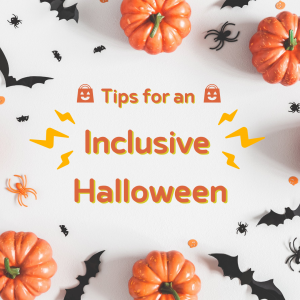An Inclusive Halloween: Making Your Festivities Fun for All
 It officially feels like fall when doorbells ring and excited exclamations of “Trick or Treat” are heard. With costumes, candy, and tons of fun, Halloween is celebrated all over the country. But this seemingly simple holiday can still present pretty significant challenges for some. The lights, colors, and loud noises from the decorations can cause sensory overload for those with sensory processing disorder, autism, and anxiety, just to name a few. The feel of the costumes can present difficulties for others. Of course, we want everyone to enjoy their time celebrating this Halloween, so it is important to approach the festivities with a little understanding.
It officially feels like fall when doorbells ring and excited exclamations of “Trick or Treat” are heard. With costumes, candy, and tons of fun, Halloween is celebrated all over the country. But this seemingly simple holiday can still present pretty significant challenges for some. The lights, colors, and loud noises from the decorations can cause sensory overload for those with sensory processing disorder, autism, and anxiety, just to name a few. The feel of the costumes can present difficulties for others. Of course, we want everyone to enjoy their time celebrating this Halloween, so it is important to approach the festivities with a little understanding.
As mentioned above, while decorations and special effects can take your Halloween celebration to a new level, they can also act as sensory triggers for some. If you’re interested in making your home a more sensory-friendly experience, try limiting these possible triggers. Some examples of common sensory triggers are loud sound effects, strobe lights, and fog machines. Costumes can be another sensory trigger. So, if you meet a trick or treater or party guest who is not wearing one, remember to be kind and understanding. Kindness also goes a long way when it comes to witnessing someone experiencing sensory overload. This can at first seem like a temper tantrum or an angry outburst, but sensory overload is extremely uncomfortable, sometimes painful, for the person experiencing it and it’s not something they can control.
Scary decorations, loud noises, and dark spaces can also affect people with anxiety, especially children. One very simple tip is to hand out candy in a well-lit area and avoid wearing anything too scary or gruesome when doing so. Jump scaring and startling the trick or treaters, of course, will get a scream or maybe even a laugh out of them. But this one event could ruin the entire night for a child with anxiety or sensory issues, so it’s best to refrain from doing so, especially to children you don’t know.
Along with costumes and decorations, sweet treats are another big part of Halloween. But food allergies and food difficulties can make this part of the Halloween celebration tricky for some. Food allergies are quite common but there are also others who experience issues with food, including diabetes, swallowing issues, or oral motor challenges. Because of this, FARE’s Teal Pumpkin Project was created. To participate in the Teal Pumpkin Project, you simply buy a teal pumpkin (or paint one teal) and hand out non-food items, such as small toys or stickers, to trick or treaters. You can hand these out along with candy or on their own.
There are also other challenges some may face that you may not even think of. For example, a nonverbal Trick or Treater may not say “Trick or Treat” or “thank you”. Or a trick or treater who appears “too old” to be participating may have an intellectual disability. Someone with low vision may need you to describe the treats you are handing out or any food present at a gathering. Those who are deaf and hard of hearing may need you to make sure you are facing them as you speak so that they can see your face and mouth. In all these cases, a little understanding and kindness goes a long way to contributing to an inclusive Halloween that everyone can enjoy. Whether you’re planning on entertaining trick or treaters or party guests, being aware of the challenges some may face can assist in making preparations that will make everyone feel welcome this Halloween.
For more information and tips on Halloween inclusivity visit https://connectingforkids.org/Halloween



 .
.
Latest News